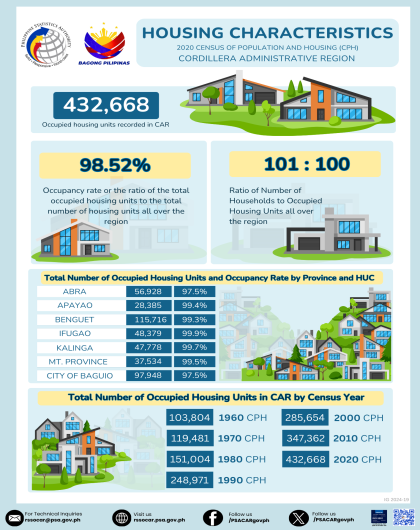Household population characteristics in CAR
- The dependency status of persons in the region can be determined by identifying three age groups. These are the 0 to 14 years old referred to as the young age group; 15 to 64 years old as the working age group; and 65 years and over as the old age group.
Figure 1. Household Population by Age-Group, CAR: 2015
- As of August 1, 2015, the household population in Cordillera totaled 1,714,220 persons, of which, 31 percent comprised the young age group. The old age group comprised only 5 percent of the region’s household population, while those in the working age group comprised 64 percent.
Overall dependency in CAR
-
The overall dependency ratio of the region was 57 persons in 2010 and 2015 censuses. This means that in every 100 persons in the working age group, there were 57 persons that belong to the young and old age groups. In theory, roughly half of the population is of working-age and supporting the other half of the population, who are either children or retired.
-
The 2017 dependency ratio decreased by 14 persons from 71 persons in 2000.
-
Out of the 57 dependents registered in CAR for 2015, 49 persons were in the young age group and 8 persons in the old age group.
-
In the three censuses, the most number of dependents in the region were aged 0 to 14 years. Those aged 65 years and over only comprised 5 percent or lower.
Young dependency in CAR by sex
- In 2015, the region had a young dependency ratio of 49 persons. Out of this ratio, 25 were males and 24 were females.
- Across the years, males outnumbered the females in the young age group.
Figure 3. Young Dependency Ratio by Sex, CAR: 2000, 2010, 2015
Old dependency in CAR by sex
- In 2015, the region had an old dependency ratio of 8 persons. Out of the ratio, 3 were males and 5 were females.
- Across the years, females outnumbered the males in the old age group.
Figure 4. Old Dependency Ratio by Sex, CAR: 2000, 2010, 2015
Overall dependency in CAR provinces
- Kalinga had the highest overall dependency ratio in the region for 2015, with 63 persons.
-
Abra and Mountain Province came second with 62 persons. Ifugao and Apayao followed at 61 persons and 58 persons, respectively.
-
The province with the lowest overall dependency ratio recorded was in Benguet with 51 persons.
-
In 2015, Benguet and Baguio City had an overall dependency ratios below the regional level.
- The overall dependency ratio of 63 in Kalinga consisted of 55 young dependents and 8 old dependents.
- In Abra, 50 persons were young dependents while 12 persons were old dependents.
-
The province of Benguet had the lowest dependency ratio of 51 persons consisting of 44 young dependents and 7 old dependents.
-
In Baguio City, the overall dependency ratio of 54 persons consisted of 48 young dependents and 6 old dependents.
Technical Notes
- Old dependency ratio is the ratio of persons aged 65 years old and over to those aged 15-64 years.
-
Young dependency ratio is the ratio of persons under 15 years old to those aged 15-64 years.


